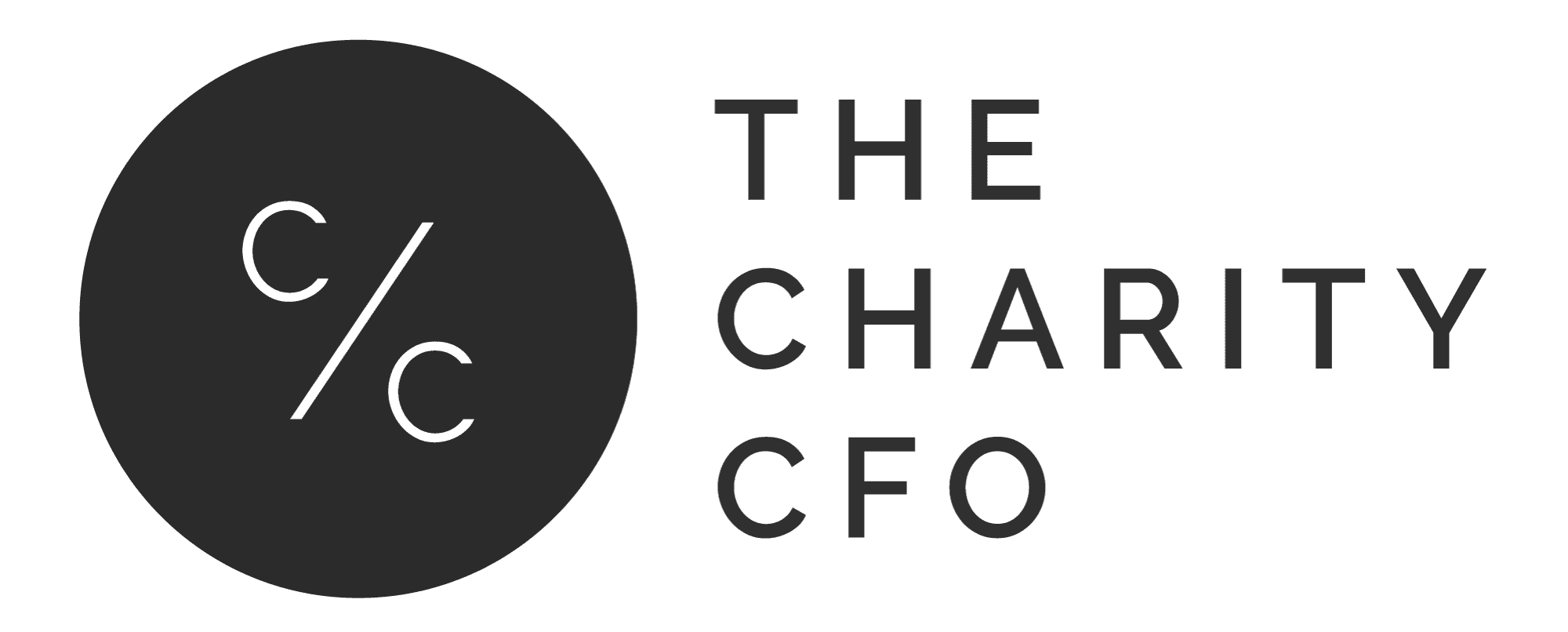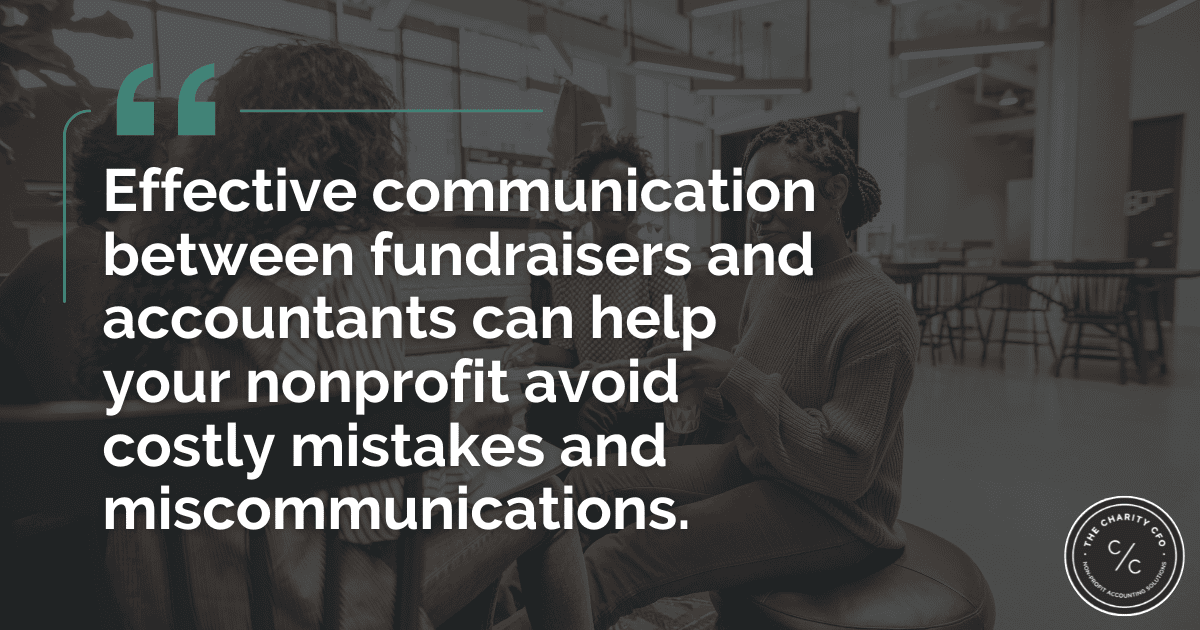How Fundraisers and Accountants can Better Communicate
No time to read this article now? Download it for later.
[button link=”https://go.thecharitycfo.com/l/995872/2024-08-23/4yn5c” color=”orange” newwindow=”yes”] Download the Article[/button]
The relationship between fundraisers and accountants in a nonprofit organization can be challenging. Fundraising and accounting departments provide vital services to the organization, but when they fail to communicate, it can lead to financial errors. Bridging this communication gap can help your organization ensure every dollar raised is used effectively.
In this article, we’ll cover the relationship between fundraisers and accountants, how each contributes to the organization, and why communication gaps exist.
We’ll also look at the most effective strategies for improving communications and how technology can help bridge the gap.

The Connection Between Fundraisers and Accountants
Both fundraisers and accountants play key roles in a nonprofit:
- Fundraisers: Drive donations, build donor relationships, and organize events that support the organization
- Accountants: Manage finances, ensure compliance, and maintain budgets
The fundraising department’s primary goal in a nonprofit is to bring in the necessary funds to support the organization’s mission. Accountants work to safeguard the financial health of the nonprofit by keeping detailed records and ensuring that funds are used appropriately.
For a nonprofit to thrive, these two departments have to work together.
Fundraising is most impactful when paired with the proper management and allocation of those funds. When fundraisers and accountants collaborate effectively, they can maximize resources to drive the organization’s mission forward.
The Gap in Communication Between Fundraisers and Accountants
Lack of communication between fundraising and accounting departments is a common issue for nonprofits. Several factors can lead to communication gaps between fundraisers and accountants, including:
- Differences in terminology and jargon: Each team uses language specific to their field, leading to misunderstandings.
- Misaligned goals and priorities: Fundraisers focus on securing funds quickly, while accountants prioritize accurate recording and management.
- Timing and urgency of information needs: The difference between when a team needs information can cause delays in gathering and reporting accurate financial data.
- Lack of regular communication channels: Teams can miss details or misinterpret information due to a lack of open and consistent communication channels.
Strategies for Better Communication Between Fundraisers and Accountants
Fundraising and accounting teams can help bridge the gaps in communication by implementing a series of strategies, including:
- Establishing clear communication channels
- Aligning goals and objectives
- Sharing transparent financial reports
- Fostering a culture of open dialogue and feedback
1. Establish Clear Communication Channels
Without clear communication channels, your fundraising and accounting teams will never be able to collaborate effectively. Defined communication channels make it easy for fundraisers and accountants to share information before making decisions.
A few ways to establish these channels include:
- Set up times for regular meetings and check-ins between fundraisers and accountants.
- Use collaborative tools and platforms–such as project management software–to modernize your nonprofit.
- Create defined points of contact for specific issues or projects.
2. Align Goals and Objectives
It’s easiest for different departments to work together when they share similar goals and objectives. Regularly scheduled joint planning sessions can help align each team’s activities with the overall goals of the nonprofit.
During these meetings, both teams can discuss upcoming fundraising campaigns, budget needs, and financial constraints to ensure everyone is on the same page. A collaborative approach reduces misunderstandings and ensures that fundraising efforts are supported by the accounting team.
Fundraising and accounting teams should also set shared objectives and nonprofit KPIs to measure success together. Working toward the same targets means accounting and fundraising teams will need to regularly check in with one another to meet shared goals. This not only improves collaboration and communication, but it can also improve the overall effectiveness of the nonprofit.
Pro Tip: In our experience, the biggest goal conflict is around the total fundraising goal. It’s important for the nonprofit’s leadership to define what the fundraising goal is. Specifically, whether the goal is on a cash-basis, “money in the door”, or aligned with how accounting has to reflect the figures in their financial reports – typically an accrual basis.
3. Transparent Financial Reporting
Accountants provide a variety of financial reports for the board of directors and other stakeholders.
The accounting team needs to make sure that the financial reports provided to fundraisers are clear and easy to understand. Simplifying complex financial data allows fundraisers to grasp the organization’s financial health and make informed decisions.
Additionally, accountants should communicate the financial impact of fundraising activities with the fundraising team. For example, accountants can explain how specific campaigns affect the budget and cash flow of the organization. This transparency helps fundraisers see the broader financial picture and plan their efforts more effectively.
4. Encourage Feedback and Open Dialogue
It’s important to remember that both the fundraising and accounting teams are essential parts of your nonprofit organization. Aim to foster an environment where both fundraisers and accountants feel comfortable sharing their insights and concerns. Encouraging open and effective communication helps identify potential issues early and promotes mutual understanding between teams.
You should also actively seek feedback from both teams through regular check-ins. Promoting ongoing dialogue makes it easier to address challenges promptly and proactively. An open line of communication helps both teams feel heard and valued in the decision-making process.
Tools and Tech Can Help Bridge the Gap, Too
You can use a variety of technology tools to help improve communication between your accounting and fundraising teams. Common technology tools for nonprofits include:
- CRM Systems and Financial Software: A CRM system makes it easy to track donor interactions while financial software helps teams manage budgets and transactions to give a comprehensive view of fundraising efforts.
- Collaboration Tools: Collaboration tools like Slack or Microsoft Teams facilitate real-time communication between fundraisers and accountants to streamline discussions, share updates, and resolve issues.
- Reporting and Analytics Platforms: Leverage reporting tools to generate visually appealing fundraising and financial reports that help track KPIs and make informed decisions.
Work With Accountants Who Communicate with Fundraisers Well
Effective communication between fundraisers and accountants can help your nonprofit avoid costly mistakes and miscommunications. Implementing the strategies discussed in this article will help your organization effectively bridge the gap between fundraising and accounting teams.
Looking for an accountant who knows how to work with fundraisers? The Charity CFO offers a wide range of accounting and financial management services for nonprofits. We know how to effectively communicate with fundraisers so your nonprofit can better meet goals and objectives.
Contact us today to get started.
No time to read this article now? Download it for later.
[button link=”https://go.thecharitycfo.com/l/995872/2024-08-23/4yn5c” color=”orange” newwindow=”yes”] Download the Article[/button]




